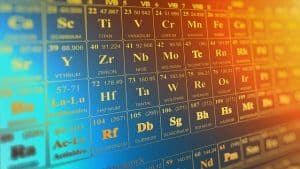 Consider all of the symbols and abbreviations we use in our daily lives. An emoticon on your cell phone is a frequent example of a sign that you use every day. You just use a smiling face to express your happiness about something.
Consider all of the symbols and abbreviations we use in our daily lives. An emoticon on your cell phone is a frequent example of a sign that you use every day. You just use a smiling face to express your happiness about something.
You don’t text ‘I’m happy about it,’ you just include a smiley face. Instead of using the full version of your name, for example, Elwin, you might use a shorthand version of your name, a nickname, like Bill. Chemical symbols are used similarly.
A chemical symbol is a simplified way of expressing an element. Instead of spelling out an element’s name, we express it with one or two letters.
The periodic table, as you may know, is a handy reference tool for chemists. The periodic table, which you will find in this article, arranges the elements according to the size of the atom that makes up the element and the characteristics of those atoms. Each element is denoted by a chemical symbol made up of letters.
What is an Atomic Number?
The number of protons in an element determines its atomic number, and it is used to distinguish one element from another. The number of protons and neutrons united in an element determines its mass number.
The contemporary periodic table is set up so that all of the elements have a growing atomic number and, as a result, an increasing mass number. But do you know what a mass number or an atomic number is?
An atom is made up of protons, electrons, and neutrons, as you may know. An atom’s valency is determined by the number of electrons in the outermost shell.
Here’s the chart of 118 elements and their symbols:
| Element | Symbol | Atomic Number |
| Hydrogen | H | 1 |
| Helium | He | 2 |
| Lithium | Li | 3 |
| Beryllium | Be | 4 |
| Boron | B | 5 |
| Carbon | C | 6 |
| Nitrogen | N | 7 |
| Oxygen | O | 8 |
| Fluorine | F | 9 |
| Neon | Ne | 10 |
| Sodium | Na | 11 |
| Magnesium | Mg | 12 |
| Aluminium | Al | 13 |
| Silicon | Si | 14 |
| Phosphorous | P | 15 |
| Sulpfur | S | 16 |
| Chlorine | Cl | 17 |
| Argon | Ar | 18 |
| Potassium | K | 19 |
| Calcium | Ca | 20 |
| Scandium | Sc | 21 |
| Titanium | Ti | 22 |
| Vanadium | V | 23 |
| Chromium | Cr | 24 |
| Manganese | Mn | 25 |
| Iron | Fe | 26 |
| Cobalt | Co | 27 |
| Nickel | Ni | 28 |
| Copper | Cu | 29 |
| Zinc | Zn | 30 |
| Gallium | Ga | 31 |
| Germanium | Ge | 32 |
| Arsenic | As | 33 |
| Selenium | Se | 34 |
| Bromine | Br | 35 |
| Krypton | Kr | 36 |
| Rubidium | Rb | 37 |
| Strontium | Sr | 38 |
| Yttrium | Y | 39 |
| Zirconium | Zr | 40 |
| Niobium | Nb | 41 |
| Molybdenum | Mo | 42 |
| Technetium | Tc | 43 |
| Ruthenium | Ru | 44 |
| Rhodium | Rh | 45 |
| Palladium | Pd | 46 |
| Silver | Ag | 47 |
| Cadmium | Cd | 48 |
| Indium | In | 49 |
| Tin | Sn | 50 |
| Antimony | Sb | 51 |
| Tellurium | Te | 52 |
| Iodine | I | 53 |
| Xenon | Xe | 54 |
| Caesium | Cs | 55 |
| Barium | Ba | 56 |
| Lanthanum | La | 57 |
| Cerium | Ce | 58 |
| Praseodymium | Pr | 59 |
| Neodymium | Nd | 60 |
| Promethium | Pm | 61 |
| Samarium | Sm | 62 |
| Europium | Eu | 63 |
| Gadolinium | Gd | 64 |
| Terbium | Tb | 65 |
| Dysprosium | Dy | 66 |
| Holmium | Ho | 67 |
| Erbium | Er | 68 |
| Thulium | Tm | 69 |
| Ytterbium | Yb | 70 |
| Lutetium | Lu | 71 |
| Hafnium | Hf | 72 |
| Tantalum | Ta | 73 |
| Tungsten | W | 74 |
| Rhenium | Re | 75 |
| Osmium | Os | 76 |
| Iridium | Ir | 77 |
| Platinum | Pt | 78 |
| Gold | Au | 79 |
| Mercury | Hg | 80 |
| Thallium | Tl | 81 |
| Lead | Pb | 82 |
| Bismuth | Bi | 83 |
| Polonium | Po | 84 |
| Astatine | At | 85 |
| Radon | Rn | 86 |
| Francium | Fr | 87 |
| Radium | Ra | 88 |
| Actinium | Ac | 89 |
| Thorium | Th | 90 |
| Protactinium | Pa | 91 |
| Uranium | U | 92 |
| Neptunium | Np | 93 |
| Plutonium | Pu | 94 |
| Americium | Am | 95 |
| Curium | Cm | 96 |
| Berkelium | Bk | 97 |
| Californium | Cf | 98 |
| Einsteinium | Es | 99 |
| Fermium | Fm | 100 |
| Mendelevium | Md | 101 |
| Nobelium | No | 102 |
| Lawrencium | Lr | 103 |
| Rutherfordium | Rf | 104 |
| Dubnium | Db | 105 |
| Seaborgium | Sg | 106 |
| Bohrium | Bh | 107 |
| Hassium | Hs | 108 |
| Meitnerium | Mt | 109 |
| Darmstadtium | Ds | 110 |
| Roentgenium | Rg | 111 |
| Copernicium | Cn | 112 |
| Nihonium | Nh | 113 |
| Flerovium | Fl | 114 |
| Moscovium | Mc | 115 |
| Livermorium | Lv | 116 |
| Tennessine | Ts | 117 |
| Oganesson | Og | 118 |
What is Valency?
The combined capacity of atoms or molecules is measured by valency. As a result, a single atom of one element can react and combine with another element’s specific number of atoms.
Electrons in an atom are grouped in several orbitals (shells) denoted by the letters L, K, M, N, etc. Valence electrons are electrons found in an atom’s outermost shell/orbit. Valence electrons participate in any chemical reaction because the electrons in the outermost orbit often have higher energy than electrons in other orbits.
According to the Bohr-bury theory, the outermost orbit of an atom will contain a maximum of 8 electrons. However, if the outermost orbit is entirely filled, the element exhibits little or no chemical activity. Their aggregate capability is reduced to zero or minimal.
Because their outermost orbit is entirely filled, noble gases are the least reactive. On the other hand, other elements’ reactivity is determined by their ability to acquire noble gas configuration. It will also aid in determining an atom’s valency.
Key Takeaways: List of the Elements
- The periodic table has 118 elements.
- The periodic table arranges the elements in ascending atomic number order.
- The number of protons in each atom of an element identifies it. This number represents the atomic number.
- Some elements’ names indicate which element group they belong to.
- Each element has a symbol that consists of one or two letters. The initial letter of each word is always capitalised. If a second letter is present, it is in lowercase.
Conclusion
There are currently no vacant places in the periodic table up to element 118. The current table has seven periods. Simultaneously, scientists are attempting to manufacture even heavier elements. Once a new element has been synthesised, the IUPAC must examine the study before a new name and symbol may be assigned.
The discoverer is allowed to propose a new name and symbol, but IUPAC has an ultimate say. The systematic element name is used until a replacement name is authorised. Element 120, for example, bears the provisional name unbinilium. This name describes the element’s atomic number, followed by the suffix -ium. Because the interim designations are tiresome, referring to an unconfirmed element by its atomic number is appropriate (e.g., element 122, element 145).



